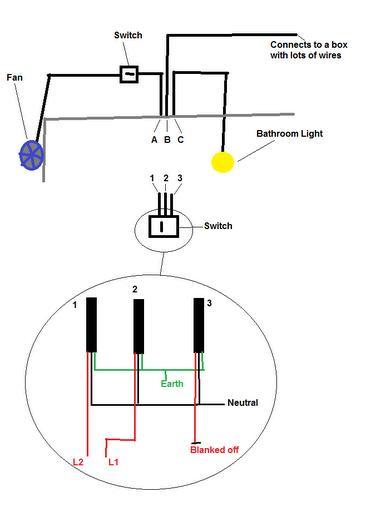I was planning on fitting an extractor fan into the bathroom. This would be switched on and off by changing the single light switch outside the bathroom into a double switch and then running the wiring up into the attic. The light switch and extractor switch would be independent of each other, just sharing the same box.
I took the front off the light switch and discovered more than I expected. It appeared to have all the wiring in place to be a double switch. I went into the attic and traced the wiring to discover there already was an extractor fan, it was just hidden behind the tiles.
I though this would make my job easier as I could simply cut the wires to the old fan and connect the new fan which I did successfully. The problem came at the switch end as I cannot tell which wires coming out of the wall are connected to which wires in the attic.
//media.diynot.com/181000_180505_41020_18438592_thumb.jpg
This diagram shows how it is wired at the moment. In this situation the light switch works fine. I have replaced the single switch with a double switch and if I wire it up the same, the light still works which is good.
What I need to know is which wires I need to connect to the L1, L2 and COM for the second switch to operate the fan. I am guessing I will need to run a wire between the two switches too.
In Summary - The picture shows what I have at the moment. I want to replace the single switch with a double switch with the two switches to work independently of each other.
Advice please.
I took the front off the light switch and discovered more than I expected. It appeared to have all the wiring in place to be a double switch. I went into the attic and traced the wiring to discover there already was an extractor fan, it was just hidden behind the tiles.
I though this would make my job easier as I could simply cut the wires to the old fan and connect the new fan which I did successfully. The problem came at the switch end as I cannot tell which wires coming out of the wall are connected to which wires in the attic.
//media.diynot.com/181000_180505_41020_18438592_thumb.jpg
This diagram shows how it is wired at the moment. In this situation the light switch works fine. I have replaced the single switch with a double switch and if I wire it up the same, the light still works which is good.
What I need to know is which wires I need to connect to the L1, L2 and COM for the second switch to operate the fan. I am guessing I will need to run a wire between the two switches too.
In Summary - The picture shows what I have at the moment. I want to replace the single switch with a double switch with the two switches to work independently of each other.
Advice please.


